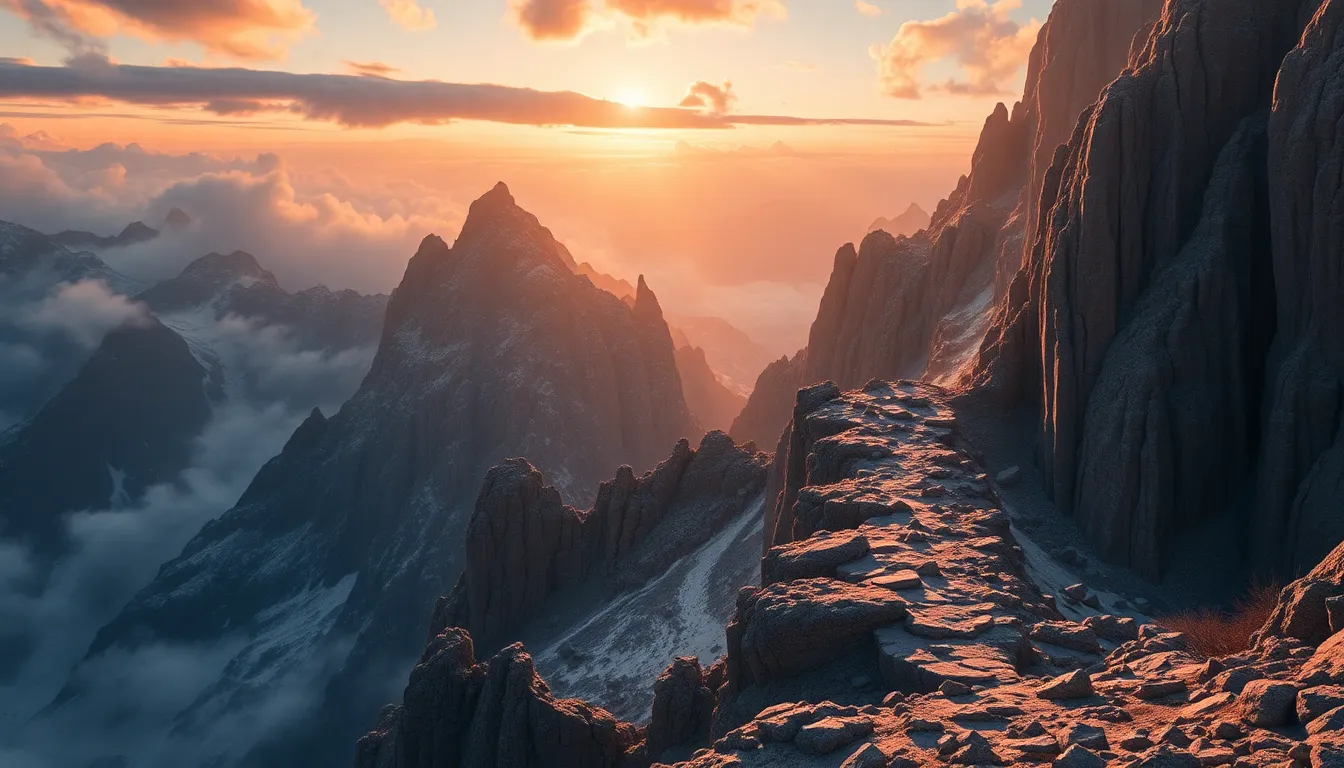The Mythical Ascent: Climbing Sacred Mountains of Legend
Introduction: The Allure of Sacred Mountains
Mountains have long captivated human imagination and aspiration, serving not only as formidable natural wonders but also as profound symbols of spiritual and cultural significance. From the towering peaks that touch the heavens to the rolling hills that cradle ancient stories, mountains have found their way into the mythologies and religions of diverse cultures around the globe. They represent a bridge between the earthly and the divine, often embodying the dreams and aspirations of those who dare to scale them.
The act of climbing these sacred mountains transcends mere adventure; it intertwines with spirituality, offering climbers a unique opportunity to connect with the legends woven into the landscape. As they ascend, climbers often find themselves reflecting on the stories and beliefs that have shaped the mountain’s identity, creating a rich tapestry of experience that blends physical challenge with spiritual exploration.
Mount Olympus: The Home of the Greek Gods
In the heart of Greece, Mount Olympus rises majestically, historically recognized as the dwelling place of the twelve Olympian gods. According to ancient Greek mythology, this sacred mountain served as the throne of Zeus, the king of the gods, and was a central point for divine intervention in human affairs.
Some of the most famous legends associated with Mount Olympus include:
- The tale of Prometheus, who defied the gods by bringing fire to humanity.
- The epic battles fought among gods and titans, shaping the cosmos as we know it.
- The annual games held in honor of Zeus, which later evolved into the Olympic Games.
In modern times, Mount Olympus attracts climbers and trekkers who seek to experience its beauty and cultural significance. The trails offer not only stunning views but also a sense of connection to the myths that echo through the ages.
Mount Fuji: The Spirit of Japan
Symbolizing beauty and impermanence, Mount Fuji holds a special place in Japanese culture and spirituality. This iconic peak is revered in Shinto and serves as a powerful symbol of Japan’s national identity. The mountain embodies the dual nature of existence—its perfect symmetry contrasting with the fleeting nature of life.
Mount Fuji is often depicted in art, literature, and poetry, emphasizing its role as a muse for countless artists throughout history. Pilgrimage routes such as the Yoshida Trail invite climbers to engage with its spiritual essence, allowing them to reflect on the themes of beauty and transience as they ascend.
Contemporary climbing experiences on Mount Fuji blend tradition with modernity, as climbers often participate in rituals that honor the mountain while also seeking personal achievement.
Kailash: The Sacred Peak of the Himalayas
Mount Kailash, revered as the sacred peak of the Himalayas, holds immense spiritual significance in Hinduism, Buddhism, Jainism, and Bon. It is considered the abode of Lord Shiva in Hindu beliefs and is believed to be the center of the universe in Buddhist cosmology.
Myths surrounding Mount Kailash include:
- The story of the celestial dance of Shiva and Parvati.
- The legends of the Buddha’s teachings being delivered at its feet.
- The belief that circumnavigating the mountain brings spiritual merit and purification.
The annual pilgrimage, known as the kora, attracts thousands of devotees who undertake the challenging journey around the mountain. This arduous trek is not just a physical challenge but also a deeply spiritual experience, offering climbers the chance to connect with the divine.
Chimborazo: The Sacred Summit of the Andes
Chimborazo, the highest mountain in Ecuador, holds significant historical and cultural importance for the indigenous peoples of the Andes, particularly the Inca civilization. The mountain is often viewed as a sacred entity, embodying the spirits of ancestors and the natural world.
The relationship between Chimborazo and the Inca civilization is profound, as it was believed to be the home of the sun god, Inti. Its peaks served as a site for rituals and offerings to ensure the favor of the gods.
Modern climbing expeditions to Chimborazo face unique challenges due to its altitude and climate. However, they also raise important questions about environmental impact and the preservation of indigenous cultures. Climbers are increasingly aware of the need to approach these sacred sites with respect and responsibility.
Mount Sinai: The Biblical Mountain of Revelation
Mount Sinai is steeped in religious significance, particularly in Judeo-Christian traditions. It is traditionally identified as the site where Moses received the Ten Commandments, making it a focal point of spiritual pilgrimage.
Legends associated with Mount Sinai include:
- The story of Moses encountering God in the burning bush.
- The thunderous revelation of the Law amidst smoke and fire.
For modern pilgrims, the ascent of Mount Sinai represents a journey of faith and introspection. Many climb the mountain in the early hours of the morning to witness the breathtaking sunrise, symbolizing enlightenment and divine revelation.
Mount Meru: The Cosmic Axis in Hindu and Buddhist Cosmology
Mount Meru is a mythical mountain in Hindu and Buddhist cosmology, often depicted as the center of all physical and spiritual universes. It symbolizes the axis mundi, connecting the earth with the divine.
In ancient texts, Mount Meru is described as a place of enlightenment, where ascension leads to spiritual awakening. The symbolism of ascent in this context is profound, as climbers seek not just to conquer the mountain but to embark on a journey of self-discovery.
The climbing challenges on Mount Meru are significant, reflecting the arduous path towards enlightenment. Climbers often share experiences of transformation, emphasizing the spiritual rewards gained through their journey.
Mount Kilimanjaro: The Roof of Africa and its Legends
Mount Kilimanjaro, the highest peak in Africa, holds immense cultural significance for the Chaga people and other tribes surrounding the mountain. It is revered not only for its breathtaking beauty but also for the myths surrounding its formation and the spirits believed to inhabit its slopes.
Some indigenous beliefs include:
- The mountain as a resting place for ancestors.
- Legends of the mountain’s creation tied to the gods.
Kilimanjaro attracts climbers from all over the world, offering diverse routes and an array of ecological zones. The ascent is not merely a physical challenge; it is also a journey through the rich cultural heritage that the mountain embodies.
The Role of Legends in Climbers’ Experiences
The myths and stories surrounding sacred mountains deeply influence modern climbers’ motivations and experiences. For many, the legends provide a sense of purpose and connection that goes beyond the personal triumph of reaching the summit.
Anecdotes from climbers often reveal a profound spiritual connection formed during their ascents. Whether through moments of reflection, encounters with nature, or the shared stories of fellow climbers, these experiences reinforce the timeless relationship between humans and the mountains.
Preserving these stories is crucial for contemporary climbing culture, ensuring that future generations understand and respect the rich tapestry of myths that enrich their journeys.
Conclusion: The Eternal Quest for Sacred
The ascent of sacred mountains is an eternal quest that intertwines adventure with spirituality. From the ancient legends that echo in the winds to the modern climbers who seek both challenge and enlightenment, these mountains stand as timeless symbols of the human spirit’s desire to reach for the divine. As we continue to explore these majestic peaks, we are reminded of the stories that have shaped our understanding of the world and our place within it.




